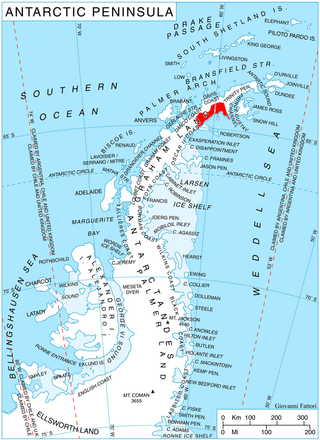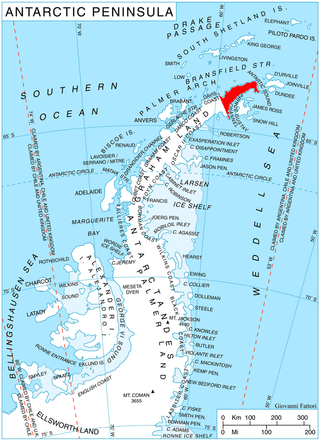Los Frentones | |
|---|---|
Municipality and village | |
| Country | |
| Province | Chaco Province |
| Time zone | UTC−3 (ART) |
Los Frentones is a village and municipality in Chaco Province in northern Argentina. [1]
Los Frentones | |
|---|---|
Municipality and village | |
| Country | |
| Province | Chaco Province |
| Time zone | UTC−3 (ART) |
Los Frentones is a village and municipality in Chaco Province in northern Argentina. [1]

The Hudson Strait links the Atlantic Ocean and the Labrador Sea to Hudson Bay in Canada. This strait lies between Baffin Island and Nunavik, with its eastern entrance marked by Cape Chidley in Newfoundland and Labrador and Resolution Island off Baffin Island. The strait is about 750 km long with an average width of 125 km, varying from 70 km at the eastern entrance to 240 km at Deception Bay.

The Arctic Archipelago, also known as the Canadian Arctic Archipelago, is an archipelago lying to the north of the Canadian continental mainland, excluding Greenland and Iceland.
The Ohio Range is a mountain range in the Transantarctic Mountains of Antarctica. It is about 48 km (30 mi) long and 16 km (10 mi) wide, extending WSW-ENE from Eldridge Peak to Mirsky Ledge. The range forms the northeast end of the Horlick Mountains and consists primarily of a large snow-topped plateau with steep northern cliffs and several flat-topped ridges and mountains. The highest point is the summit of Mount Schopf.

Alvarenga is a Brazilian municipality in the state of Minas Gerais. As of 2020 its population is estimated to be 3,844.
Mero is a small town in Saint Joseph Parish, Dominica. It is located in the west of the island, to the north of the mouth of the Layou River. To the north of Mero is Baroui and to the south of Mero is Saint Joseph.
Zaneveld Glacier is a broad tributary glacier, flowing from the polar plateau northwest between Roberts Massif and Cumulus Hills to enter the upper part of Shackleton Glacier. Named by Advisory Committee on Antarctic Names (US-ACAN) for Jacques S. Zaneveld, United States Antarctic Research Program (USARP) biologist at McMurdo Station, 1963–64 and 1964–65, who participated in the cruise of the USS Glacier, January–March 1965.
Gain Glacier is a large glacier on the east coast of Palmer Land, Antarctica, flowing northeast from Cat Ridge and entering the Weddell Sea between Imshaug Peninsula and Morency Island. It was mapped by the United States Geological Survey in 1974, and was named by the Advisory Committee on Antarctic Names for Louis Gain, a naturalist on the French Antarctic Expedition, 1908–10, and the author of several of the expedition reports on zoology and botany.
Papanduva is a municipality in the state of Santa Catarina in the South region of Brazil.

Blériot Glacier is a short, but wide, glacier lying east of Salvesen Cove and Zimzelen Glacier and southwest of Cayley Glacier on Danco Coast, Graham Land in Antarctica. Photographed by the Falkland Islands and Dependencies Aerial Survey Expedition in 1956–57, and mapped from these photos by the Falkland Islands Dependencies Survey, it was named by the UK Antarctic Place-Names Committee in 1960 for Louis Blériot (1872–1936), a French aviator who in 1907 flew the first full-size powered monoplane, and who made the first flight across the English Channel in July 1909.
Böhnecke Glacier is a steep glacier 3 nautical miles (6 km) wide, which flows southeast to the northwest side of Violante Inlet, on the east coast of Palmer Land. It was discovered and photographed from the air in December 1940 by members of the United States Antarctic Service. During 1947 the glacier was photographed from the air by members of the Ronne Antarctic Research Expedition under Finn Ronne, who in conjunction with the Falkland Islands Dependencies Survey (FIDS) charted it from the ground. It was named by FIDS for Gunther Böhnecke, a German oceanographer and a member of the German expedition in the Meteor, 1925–27.
Chambers Glacier is a glacier in the Forrestal Range of the Pensacola Mountains, draining east from Mount Lechner and Kent Gap, at the juncture of Saratoga Table and Lexington Table, to enter Support Force Glacier. It was discovered and photographed on January 13, 1956, on a transcontinental patrol plane flight of U.S. Navy Operation Deep Freeze I from McMurdo Sound to the vicinity of the Weddell Sea and return. It was named by the Advisory Committee on Antarctic Names after Captain Washington I. Chambers, U.S. Navy, one of the pioneers in the development of the airplane catapult for ships.

Eliason Glacier is a glacier 5 nautical miles (9 km) long close west of Mount Hornsby, flowing south from Detroit Plateau into the ice piedmont north of Larsen Inlet, Nordenskjöld Coast in northern Graham Land, Antarctica. It was mapped from surveys by the Falkland Islands Dependencies Survey (1960–61), and was named by the UK Antarctic Place-Names Committee after the Eliason motor sledge, invented in 1942 in Sweden, now made in Canada, and used in Arctic Canada since 1950 and in the Antarctic since 1960.

Patton Glacier is a broad tributary glacier in the Sentinel Range, Ellsworth Mountains. It drains the east slope of the main ridge between Mounts Ostenso and Tyree, flows east-northeastwards between Evans Peak and Versinikia Peak on the north and Mount Bearskin on the south, and enters Ellen Glacier northeast of Zalmoxis Peak and southeast of Mount Jumper.
Foster Plateau is a plateau, about 80 square miles (210 km2) in area, lying between Drygalski Glacier and Hektoria Glacier in northern Graham Land, Antarctica. It borders Forbidden Plateau on the south and Herbert Plateau on the north. The feature was photographed by the Falkland Islands and Dependencies Aerial Survey Expedition in 1956–57 and mapped from these photos by the Falkland Islands Dependencies Survey (FIDS). It was named by the UK Antarctic Place-Names Committee in 1960 for Richard A. Foster, FIDS leader of the Danco Island station in 1956 and 1957.
Minstrel Point is a point about midway between Cape Lindsey and Cape Yelcho on the west coast of Elephant Island, in the South Shetland Islands off Antarctica. It was named by the UK Joint Services Expedition to Elephant Island of 1970–71, after the brig Minstrel, a sealer from London, which anchored north of this feature in February 1821.
Santos Peak is a peak lying south of Murray Island, on the west coast of Graham Land. Charted by the Belgian Antarctic Expedition under Gerlache, 1897–99. Named by the United Kingdom Antarctic Place-Names Committee (UK-APC) in 1960 for Alberto Santos-Dumont (1873–1932), Brazilian inventor resident in France, who designed and flew 14 small airships and accomplished the first official powered flight in Europe in 1906.
Snyder Peninsula is a high, ice-covered peninsula on the south side of Lamplugh Inlet terminating in Cape Howard, on the east coast of Palmer Land. Mapped by the United States Geological Survey (USGS) in 1974. Named by Advisory Committee on Antarctic Names (US-ACAN) for R. Admiral Joseph E. Snyder, Jr., U.S. Navy, Antarctic project Officer for the Assistant Secretary of the Navy for Research and Development, 1967–69.

Kenney Glacier is a glacier 1 nmi long flowing northwest from The Pyramid and The Saddlestone into Depot Glacier, near the head of Hope Bay, Trinity Peninsula, Antarctica. It was mapped in 1945 and 1948 by the Falkland Islands Dependencies Survey (FIDS), was resurveyed by the FIDS in 1955, and was named for Richard Kenney, assistant surveyor at Hope Bay in 1954 and 1955, who made a detailed local survey of the area between Hope Bay and Duse Bay.

The Subprefecture of Guaianases is one of 32 subprefectures of the city of São Paulo, Brazil. It comprises two districts: Guaianases and Lajeado.